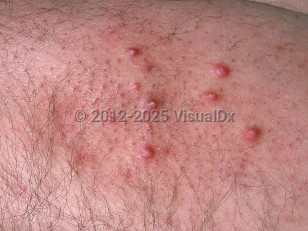Kyrle disease in Child
Alerts and Notices
Important News & Links
Synopsis

Kyrle disease, also known as hyperkeratosis follicularis et parafollicularis in cutem penetrans, is 1 of 4 classic perforating dermatoses that are now grouped under the umbrella term of "acquired perforating dermatoses" along with elastosis perforans serpiginosa, perforating folliculitis, and reactive perforating collagenosis. Acquired perforating dermatoses are often associated with diabetes mellitus or chronic renal disease; however, they may also occur in patients with other systemic diseases, in association with medications (elastosis perforans serpiginosa, perforating folliculitis), and in patients without an underlying disease.
The cause of Kyrle disease is unknown, but the pathomechanisms are thought to be multifactorial including repeated trauma such as scratching or rubbing, microangiopathy from diabetes, abnormal metalloproteinase activity, transforming growth factor (TGF)-beta3 overexpression, and deposition of uric acid, hydroxyapatite, or silicon. Associations with nephropathy secondary to diabetes and with congestive heart failure and liver disease have been proposed.
Age of onset is generally between the third and fifth decade with an average age of onset of 30 years old. Kyrle disease is very rare in children and has been reported in individuals up to age 63. There seems to be no predilection for sex or race / ethnicity. The disease is rare except when seen in association with renal failure and is not uncommon in hemodialysis patients who have pruritus. Kyrle lesions are found in about 10% of patients on hemodialysis secondary to diabetic nephropathy. Other precipitating factors that have been postulated include infection, disorder of vitamin A and/or D metabolism, medications, and genetics.
Kyrle disease classically presents as multiple discrete hyperkeratotic follicular and nonfollicular papules with central crusts or hyperkeratotic plugs. When central plugs come away, pit-like depressions are left (Kyrle phenomenon). The plugs consist of keratin. However, elastic fibers and collagen can be present as well.
Pruritus may be present. Koebner phenomenon (lesions forming at sites of skin trauma) is not generally seen, in contrast to some of the other perforating disorders.
The cause of Kyrle disease is unknown, but the pathomechanisms are thought to be multifactorial including repeated trauma such as scratching or rubbing, microangiopathy from diabetes, abnormal metalloproteinase activity, transforming growth factor (TGF)-beta3 overexpression, and deposition of uric acid, hydroxyapatite, or silicon. Associations with nephropathy secondary to diabetes and with congestive heart failure and liver disease have been proposed.
Age of onset is generally between the third and fifth decade with an average age of onset of 30 years old. Kyrle disease is very rare in children and has been reported in individuals up to age 63. There seems to be no predilection for sex or race / ethnicity. The disease is rare except when seen in association with renal failure and is not uncommon in hemodialysis patients who have pruritus. Kyrle lesions are found in about 10% of patients on hemodialysis secondary to diabetic nephropathy. Other precipitating factors that have been postulated include infection, disorder of vitamin A and/or D metabolism, medications, and genetics.
Kyrle disease classically presents as multiple discrete hyperkeratotic follicular and nonfollicular papules with central crusts or hyperkeratotic plugs. When central plugs come away, pit-like depressions are left (Kyrle phenomenon). The plugs consist of keratin. However, elastic fibers and collagen can be present as well.
Pruritus may be present. Koebner phenomenon (lesions forming at sites of skin trauma) is not generally seen, in contrast to some of the other perforating disorders.
Codes
ICD10CM:
L87.0 – Keratosis follicularis et parafollicularis in cutem penetrans
SNOMEDCT:
34042008 – Hyperkeratosis follicularis in cutem penetrans
L87.0 – Keratosis follicularis et parafollicularis in cutem penetrans
SNOMEDCT:
34042008 – Hyperkeratosis follicularis in cutem penetrans
Look For
Subscription Required
Diagnostic Pearls
Subscription Required
Differential Diagnosis & Pitfalls

To perform a comparison, select diagnoses from the classic differential
Subscription Required
Best Tests
Subscription Required
Management Pearls
Subscription Required
Therapy
Subscription Required
References
Subscription Required
Last Reviewed:04/28/2021
Last Updated:05/09/2021
Last Updated:05/09/2021
Kyrle disease in Child

